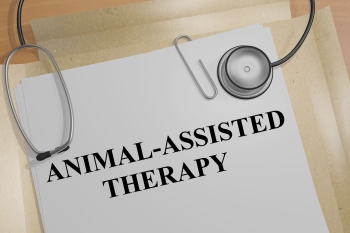
Pet therapy, or Animal Assisted Therapy (AAT) refers to the use of animals in therapy as part of the treatment process. Animal Assisted Therapy ( AAT ) attempts to improve a human’s physical, social, emotional, and/or cognitive functioning (Wesley, 2006). It is used as an adjunct to individual, group, and family therapy sessions held in both outpatient and residential settings. The animals are usually dogs, but other animals are used depending on the needs of the person or group. The purpose of using the animal in the treatment process is different for each person or group being treated. However, the general theory is that the animals make it easier for people to benefit from therapy.
Having an animal present can normalize a stressful situation and act as a buffer against anxiety. Studies show that interacting with a dog is less stressful for people than talking to another person (Vormbrok and Grossberg, 1988). Allowing people who feel anxious and stressed when disclosing personal information to a therapist to communicate to the animal instead can alleviate stress, and make it easier for the patient to be open and honest. Sigmund Freud used his dog Jofi in therapy. He used to communicate comments and interpretations through Jofi, and patients would understand, and communicate back (Walsh 2009). Freud found that people felt less stress with Jofi there, and less stress talking to Jofi than Freud, until gradually they felt more comfortable talking directly to Freud.
Another use of AAT is that it can change people’s perception of the therapist and environment, which may make therapy less threatening and more friendly (Friedmann, 1983). For example, children who are resistant to talking to a therapist have been more likely to trust him or her, and talk more freely after bringing an animal into the treatment process (Wesley, 2006). They didn’t speak to the animal, but perceived the therapist as someone they were willing to open up to.
Coping with stress is a major role that therapy animals play. When people feel stress, their heart rates and blood pressure rise. Feeling stress interferes with progressing in therapy. For people who find therapy stressful, having a pet present can help because it lowers people’s blood pressure and heart rate, relieving their anxiety (Friedmann, 1983).
Theories for the calming effect of pet therapy are that animals distract people from focusing on their anxiety; it changes the perception of the therapist and environment positively; and the interaction of petting the dog will physically calm both the human and animal, decreasing blood pressure and heart rate (Baun, Bergstrom, Langston, & Thoma, 1983).
A number of studies show benefits of using animals for healing and development in individual, group, couples and family therapy, in a variety of inpatient and outpatient settings. The benefits extend to populations of all ages.
Pet therapy is widely used in nursing homes because animals have many benefits to elderly people. Pet therapy improves their social skills and motivates them to be more physically active (Wesley, 2006). Often elderly people in a nursing home will be gathered in a group while therapy animals are brought into their facility by a pet therapy organization. Animal Assisted Therapy AAT is a chance for the elderly group to pet the dogs, talk to them, walk them and talk to the other people in the group about the dog. Because the people are so excited, they talk to the other group members more than they did without animals present. Some ask to take the dogs for a walk, which promotes physical activity. Elderly people feel a sense of being needed by giving the dogs their food, taking them for a walk, and giving them love. In turn, pet therapy aids in reducing depression and loneliness in that population (Wesley, 2006)).
Pet therapy is beneficial for children too. Studies were done with male children between the ages of 9-15 who were diagnosed with ADHD. Having the animals present, made them less nervous, helped the kids see the therapist as more likeable, and they felt more comfortable talking to her. The animals also decreased their agitation and lowered aggressive behavior (Wesley, 2006). Children were the first population that Boris Levinson, the “father of pet therapy,” researched to document the benefits of pet therapy. Among many things, he found that the therapeutic relationship between him and his child patients could begin much faster when using an animal (Lacoff, 1999).
Studies also showed a decrease in agitation and lowered aggressive behavior in psychiatric patients with mood disorders, psychotic disorders, substance use disorders, anxiety, personality disorders and cognitive disorders. The animals reduced stressors and lowered blood pressure in this group (Wesley, 2006).
Pet therapy is beneficial in couple’s and family therapy too. When threatening issues arise, holding and stroking animals can reduce anxiety. Animals can also moderate escalating conflict between spouses. When a child is impulsive or misbehaves, there are teachable moments for parents in handling child behavior problems as therapists model discipline or problem solving strategies with positive reinforcements, and clarify what the animal is seeking (Walsh, 2009).
The use of animals in therapy was documented as early as 1792 by the York Retreat, a residential facility for the mentally disturbed in England (Hooker, Freeman & Stewart, 2002). The Quakers introduced animals in treatment rather than using the cruel treatment methodologies of that time period (Wesley, 2006). Scientific research involving pet therapy wasn’t documented until the 1960’s when child psychiatrist Boris Levinson noticed dramatic improvement in his patients with the use of his animals. He began conducting, documenting and presenting his research to colleagues. He eventually coined the term, “pet therapy.” At the time, he was met with ridicule by other therapists.
In the 1970’s and 1980’s, research into pet therapy began to flourish, and continues today. Psychiatric patients and cardiology patients are in the forefront of the research, and mental and physical benefits to pet therapy and dog ownership continue to be confirmed and expanded on.
Bibliography
Baun, M., Bergstrom, N., Langston, N., Thoma, L. (1984). Physiological
Effects of Human/Animal Bonding. Nursing Research. (83), 3.
Friedmann, E., Katcher, A., Thomas, S. Lynch, J. Messent, P. (1983). Social
Interaction and Blood Pressure. Influence of Animal Companions. The Journal of Nervous and Mental Disease. (171), 461-465.
Hooker, S., Freeman, L., Stewart, P. (2002). Pet Therapy Research: A
Historical Review. Holistic Nursing Practice. 17(1), 17-23.
Lacoff, S. (1999). Boris M. Levinson, A Historical Perspective: A Focus On
His Work Involving Animal Assisted Psychotherapy. (Doctoral Dissertation). Retrieved from PsychInfo Database.
Vormbrock, J., Grossbert, J. (1988). Cardiovascular Effects of Human-Pet
Dog Interactions. Journal of Behavioral Medicine. (11), 509-517.
Walsh, F. (2009). Human-Animal Bonds II: The Role of Pets in Family
Systems and Family Therapy. Family Process. (48), 481-499.
Wesley, M. (2006). Animal Assisted Therapy and the Therapeutic Alliance
In The Treatment Of Substance Dependence. (Doctoral
Dissertation). Retrieved from PsychInfo Database.
At TCFG you can schedule directly online with a therapist. If you prefer talking to a therapist first, you may call (215) 922-LOVE (5683) ext 100 to be connected with our intake department. Lastly, you can call our Director, “Alex” Caroline Robboy, CAS, MSW, LCSW at (267) 324–9564 to discuss your particular situation. For your convenience, we have six physical therapy offices and can also provide counseling and therapy virtually.
- Ocean City Therapy Office
360 West Ave, Floor 1, Ocean City, NJ 08226 - Mechanicsville Therapy Office
9044 Mann Drive, Mechanicsville Virginia, 23116 - Providence Therapy Office
173 Waterman St. Providence, RI 02906 - Society Hill Therapy Office
233 S. 6th Street, C-33, Philadelphia PA 19106 - Art Museum / Fairmount Therapy Office
2401 Pennsylvania Ave, Suite 1a2, Philadelphia PA 19130 - Santa Fe Therapy Office, 2204 B Brothers Road, Santa Fe, New Mexico, 87505
- Telemedicine: We have therapists who are licensed to work in Connecticut, Florida, Georgia, New Jersey, New Mexico, Pennsylvania, Rhode Island, and Virginia.
OUR GUARANTEE: you deserve the best therapist possible. If you don't feel like the therapist that you met with was the right fit, then free of charge you can try out a different therapist. Being in a group practices allows for flexibility.
The Center for Growth has offices in multiple states. We offer both Counseling and Therapy in-person as well as virtual appointments.
The Center for Growth Therapy Offices in PA, NJ, VA, RI, NM, CT, FL, GA
Therapy Services Offered in Philadelphia, Ocean City, Mechanicsville, Providence, Santa Fe:
Individual Counseling psychotherapy and therapy
Couples Counseling relationship counseling, marriage counseling
Teen Therapy and Adolescent Therapy and tweens and play therapy
Family Therapy and multi-generational counseling and blended families
Art Therapy and Counseling no art skills needed, just an open mind
ADHD Therapy neurodiversity (ADD, Dyslexia, Autism, Tourettes counseling)
Anxiety, Panic, OCD Therapy worry angst. and fear
Breaking the cycle of Codependency and being your own person, individuation
Overcoming Chronic Illness and Chronic Pain not everyone has it easy
Depression Therapy and sadness, gloom, and upset support
- Functional Neurological Disorder (FND) Therapy is a particular style of therapy designed for people with problems affecting their nervous system, how the brain and body send and receive signals.
Grief Therapy and loss, End of A Relationship, rejections, pregnancy and loss and therapy
Mindfulness Based Therapy and spirituality based therapy
- Narcissistic Abuse Recovery child of, parent of, spouse of, siblings of a narcissist, friend of.
Sex Therapy and sexual function & dysfunction, sexual compulsion, sexual orientation and gender identity , sexual trauma and much much more
Shame and Blame and anger
Trauma Therapy both emotional and sexual abuse, complex trauma, PTSD counseling
Divorce support
Affairs, Infidelity, Unfaithful, Cheating counseling and relationship repair work
Parenting therapy and coparenting and grand-parenting and step-parenting
Personality disorder therapy narcissism, borderline, workaholic, histrionic
Anger Management Therapy frustration, mad, angry and annoyed
Setting Boundaries and identifying ones own Core Beliefs and integrity
Just to name some of the Mental Health issues that we work with. Our goal is to help you Change and Achieve Your Dreams






















